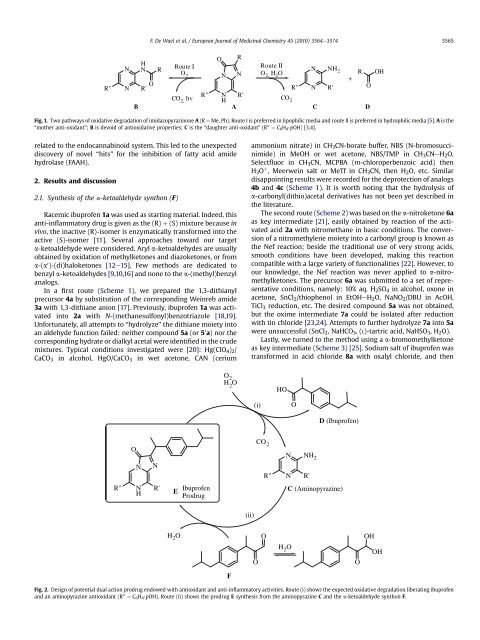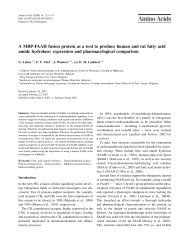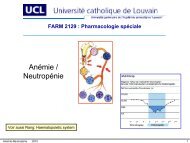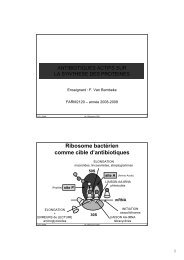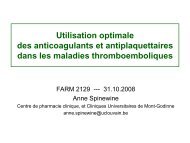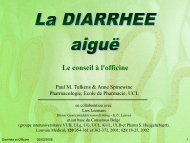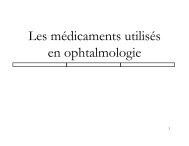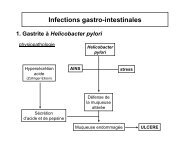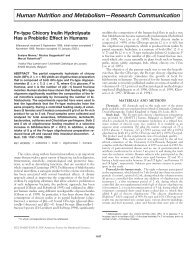Chemistry around imidazopyrazine and ibuprofen - UCL-Bruxelles ...
Chemistry around imidazopyrazine and ibuprofen - UCL-Bruxelles ...
Chemistry around imidazopyrazine and ibuprofen - UCL-Bruxelles ...
You also want an ePaper? Increase the reach of your titles
YUMPU automatically turns print PDFs into web optimized ePapers that Google loves.
elated to the endocannabinoid system. This led to the unexpected<br />
discovery of novel “hits” for the inhibition of fatty acid amide<br />
hydrolase (FAAH).<br />
2. Results <strong>and</strong> discussion<br />
R"<br />
N<br />
N<br />
H<br />
N<br />
O<br />
R'<br />
R<br />
Route I<br />
O2 O<br />
N<br />
R<br />
N<br />
Route II<br />
O2, H2O R"<br />
N<br />
N<br />
NH2 R'<br />
+<br />
R<br />
O<br />
OH<br />
CO2, hv<br />
R" N<br />
H<br />
R'<br />
CO2 B A C D<br />
Fig. 1. Two pathways of oxidative degradation of imidazopyrazinone A (R ¼ Me, Ph). Route I is preferred in lipophilic media <strong>and</strong> route II is preferred in hydrophilic media [5]. A is the<br />
“mother anti-oxidant”; B is devoid of antioxidative properties; C is the “daughter anti-oxidant” (R 00 ¼ C6H4-pOH) [3,4].<br />
2.1. Synthesis of the a-ketoaldehyde synthon (F)<br />
Racemic <strong>ibuprofen</strong> 1a was used as starting material. Indeed, this<br />
anti-inflammatory drug is given as the (R) þ (S) mixture because in<br />
vivo, the inactive (R)-isomer is enzymatically transformed into the<br />
active (S)-isomer [11]. Several approaches toward our target<br />
a-ketoaldehyde were considered. Aryl a-ketoaldehydes are usually<br />
obtained by oxidation of methylketones <strong>and</strong> diazoketones, or from<br />
a-(a 0 )-(di)haloketones [12e15]. Few methods are dedicated to<br />
benzyl a-ketoaldehydes [9,10,16] <strong>and</strong> none to the a-(methyl)benzyl<br />
analogs.<br />
In a first route (Scheme 1), we prepared the 1,3-dithianyl<br />
precursor 4a by substitution of the corresponding Weinreb amide<br />
3a with 1,3-dithiane anion [17]. Previously, <strong>ibuprofen</strong> 1a was activated<br />
into 2a with N-(methanesulfonyl)benzotriazole [18,19].<br />
Unfortunately, all attempts to “hydrolyze” the dithiane moiety into<br />
an aldehyde function failed: neither compound 5a (or 5 0 a) nor the<br />
corresponding hydrate or dialkyl acetal were identified in the crude<br />
mixtures. Typical conditions investigated were [20]: Hg(ClO4)2/<br />
CaCO3 in alcohol, HgO/CaCO3 in wet acetone, CAN (cerium<br />
O<br />
N<br />
N<br />
R" N R'<br />
H<br />
F. De Wael et al. / European Journal of Medicinal <strong>Chemistry</strong> 45 (2010) 3564e3574 3565<br />
E<br />
H 2 O<br />
Ibuprofen<br />
Prodrug<br />
O 2<br />
H 2 O<br />
F<br />
ammonium nitrate) in CH3CN-borate buffer, NBS (N-bromosuccinimide)<br />
in MeOH or wet acetone, NBS/TMP in CH3CNeH2O,<br />
Selectfluor in CH3CN, MCPBA (m-chloroperbenzoic acid) then<br />
H3O þ , Meerwein salt or MeTf in CH3CN, then H2O, etc. Similar<br />
disappointing results were recorded for the deprotection of analogs<br />
4b <strong>and</strong> 4c (Scheme 1). It is worth noting that the hydrolysis of<br />
a-carbonyl(dithio)acetal derivatives has not been yet described in<br />
the literature.<br />
The second route (Scheme 2) was based on the a-nitroketone 6a<br />
as key intermediate [21], easily obtained by reaction of the activated<br />
acid 2a with nitromethane in basic conditions. The conversion<br />
of a nitromethylene moiety into a carbonyl group is known as<br />
the Nef reaction; beside the traditional use of very strong acids,<br />
smooth conditions have been developed, making this reaction<br />
compatible with a large variety of functionalities [22]. However, to<br />
our knowledge, the Nef reaction was never applied to a-nitromethylketones.<br />
The precursor 6a was submitted to a set of representative<br />
conditions, namely: 10% aq. H2SO4 in alcohol, oxone in<br />
acetone, SnCl2/thiophenol in EtOHeH2O, NaNO2/DBU in AcOH,<br />
TiCl3 reduction, etc. The desired compound 5a was not obtained,<br />
but the oxime intermediate 7a could be isolated after reduction<br />
with tin chloride [23,24]. Attempts to further hydrolyze 7a into 5a<br />
were unsuccessful (SnCl2, NaHCO3, (L)-tartric acid, NaHSO3, H2O).<br />
Lastly, we turned to the method using a a-bromomethylketone<br />
as key intermediate (Scheme 3) [25]. Sodium salt of <strong>ibuprofen</strong> was<br />
transformed in acid chloride 8a with oxalyl chloride, <strong>and</strong> then<br />
O<br />
N<br />
NH 2<br />
R" N R'<br />
O<br />
HO<br />
H 2 O<br />
O<br />
D (Ibuprofen)<br />
C (Aminopyrazine)<br />
Fig. 2. Design of potential dual action prodrug endowed with antioxidant <strong>and</strong> anti-inflammatory activities. Route (i) shows the expected oxidative degradation liberating <strong>ibuprofen</strong><br />
<strong>and</strong> an aminopyrazine antioxidant (R 00 ¼ C6H4-pOH). Route (ii) shows the prodrug E synthesis from the aminopyrazine C <strong>and</strong> the a-ketoaldehyde synthon F.<br />
(ii)<br />
(i)<br />
CO 2<br />
O<br />
OH<br />
OH


